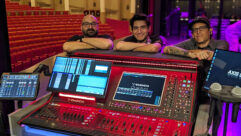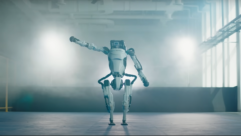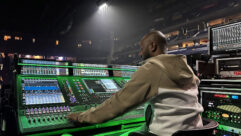With an enduring legacy spanning more than five decades, the members of Chicago rock band Styx are still showing no signs of calling it quits. In fact, the group is currently out on the road supporting its 17th studio album, Crash of the Crown, in the final stretch of a 95-date 2023 US tour that runs into November. And while Styx may be relying on local “racks and stacks” at the various host venues on their latest trek, the band’s audio crew has opted to carry a Solotech-supplied control package built upon twin DiGiCo SD12-96 consoles for paramount FOH and monitor mix consistency.
Chris Hoff, better known as “Cookie,” has worked with the band on and off for more than half of its history, originally starting out as a stage patch/monitor tech in 1997. Following eight years as the band’s monitor engineer, plus various stints as systems engineer, Hoff has spent the past six years as Styx’s FOH engineer, and he says that the choice to specify DiGiCo consoles was an easy one.
“I absolutely love the DiGiCo mixing platform; there is so much flexibility and so many extra features that set this platform apart,” he says. “Once I get my ‘propeller-head’ engineering done—routing, groups, macros, and so on—I feel that I’m free to mix creatively and musically. I don’t have to spend all of my time fixing things and I can fully participate in the performance from my end.
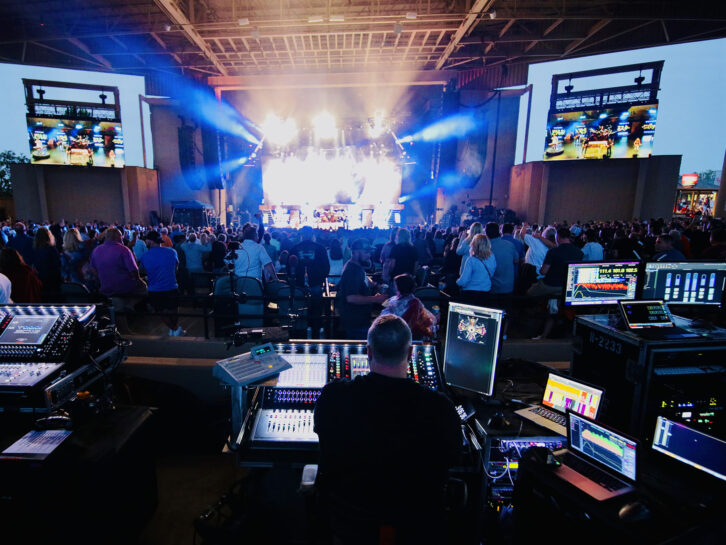
“I’ve worked on a variety of DiGiCo surfaces—SD7, SD5, SD10, and Quantum7—on both sides of the snake since 2015, but the SD12-96 was particularly ideal for this tour in that it helped us resolve some space challenges. Evan [McElhinney, monitor engineer] and I try to do as much as we can with as little as possible. Neither of us have a bunch of outboard gear to make our socials look cool, nor do we really need it. From my perspective at front-of-house, there are many venues that feel even a four-foot-wide desk is way too big and they don’t seem to budget enough room for what we are bringing in. The SD12-96 is a high-channel count console in a very small yet convenient package that has the same pedigree and amenities of its much larger siblings.”
Solotech’s control package for the current Styx tour comprises the two DiGiCo consoles connected via HMA Optocore and paired with an SD-Rack loaded with two 24-bit AD cards, three 32-bit AD cards, one AES I/O card, and five DA cards on the output side. Hoff has DMI-Waves and DMI-MADI modules loaded into his desk’s rear panel, and he’s using two Waves DiGiGrid MGBs for virtual soundcheck. Audio from a secondary playback computer is additionally brought in on the console’s UB-MADI port.
Hoff notes that he makes extensive use of the SD12-96’s macros. “Macros, oh, how I heart thee,” he grins. “I have macros that kick out inserts and kick in parameters to keep the show going and sounding similar case of server errors. Other macros move pans on certain inputs for me no matter what layer I am in. And there are macros that set delay times, tap tempos, turn on/off effects, adjust lighting, and other things. These things save me so much time and are always accessible.”
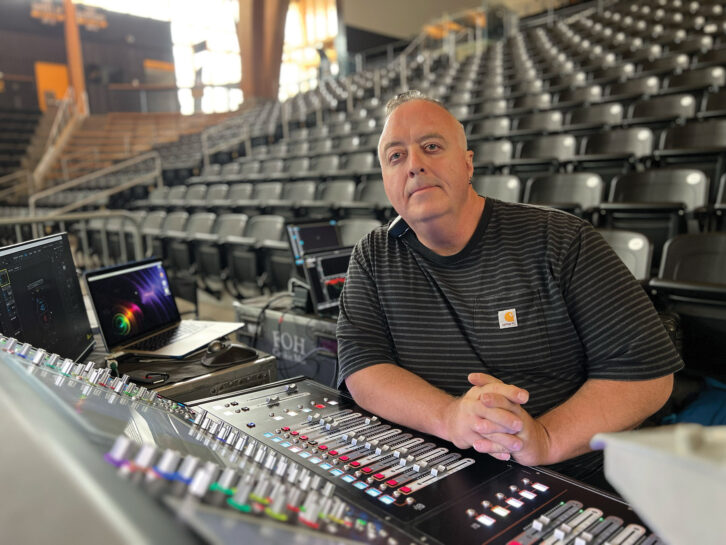
Having first used an SD12 prior to the availability of its 96-channel software upgrade, Hoff notes that he found numerous functions to help maximize the desk’s I/O. “For instance, one feature I love having is the alt input,” he says. “My pink channel is also Evan’s talkback to me—only one is used at a time, so that just takes up one fader. Another use of the alt input, which seems so simple, is that we had singers that would swap mics. The alt input was used in conjunction with a macro that would swap the inputs on the fly so we didn’t have to worry about processing chains or mix assignments.
“It’s hard to pick which feature I love the most, though, because I also have to mention the routing options on this platform. Being able to take channel inputs from internal busses, like auxes or groups, or the fact that you can route groups to a group or send a group to an aux really can’t be understated. This feature is a huge flexibility option no matter if you are at FOH or monitors, or have 32 inputs or 320 inputs. Being able to route pretty much wherever you can imagine opens up so many more possibilities in your mix and creativity.”
On the other end of the fiber is monitor engineer Evan McElhinney, who has been with the band since 2010. “Although I spent my first seven years with the Styx family on another brand of console, we finally maxed out that platform’s resources; plus, the band’s newer records were presenting a need for the monitor situation to evolve. In 2017, Cookie and I both agreed that DiGiCo’s SD-Range was the best option for Styx moving forward, and when the SD12 dropped, I was immediately fond of it based on its footprint and features.”
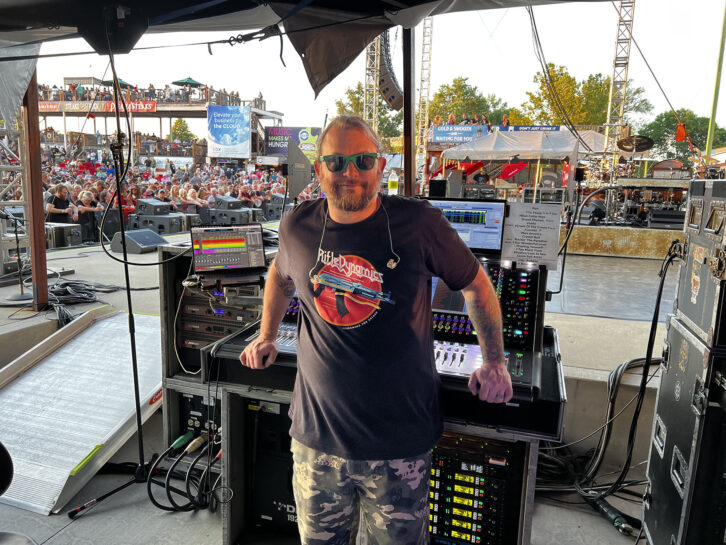
Similar to Hoff, McElhinney’s desk is paired with a Waves DiGiGrid MGB and a DMI-Waves card taking care of his multitrack record and virtual soundcheck, but he eschews outboard processing for the desk’s internal offerings. “I don’t use external plugins or anything with this artist; everything I need is onboard,” he says. “I really like the dynamic EQ, which I use in conjunction with more heavily compressed vocal channels to parallel in with the main vocal for the artist. It allows me to set it so the HF boost on the channel isn’t activated by drums when the artist steps away from the mic, only when they are singing, which helps keep the mix cleaner. And I absolutely love the audio enhancer inserted on my snare top channel. It makes it sound fat and helps it punch right through the mix.”
McElhinney uses his console to supply a dozen wireless IEM mixes for the band and crew, three wired packs at the drum riser, and a small number of transducers onstage, and the response that’s he’s gotten back from the group has been affirming. “I have been told by some of the guys that it’s the most fun they have had playing in their careers,” he says. “Tommy [Shaw, guitar/vocal] often is excited by how good his mix sounds and how inspiring it is to play. One thing that matters most to me is that they can pitch easily, which is crucial for a vocal band like this where all of them sing.
“The SD12-96 is such a fun console to mix on. I have an analog mindset for my mix, so I never really do sends on faders. Using the snapshots for different songs to switch certain things from pre to post when necessary in conjunction with control groups allows me to consolidate a lot of moves down to one fader so I can keep my eyes on the stage and know that the moves I’m making are doing what they need to do for the individual players. I am a ‘yes’ person; I do not like to say ‘no’ to the artists when they have a request or an ‘is this possible’ moment. The DiGiCo platform with its amazing flexibility, intuitive routing, and unparalleled processing power allows me to present to the artists whatever they desire, and I am barely even scratching the surface of what the desk is capable of.”
For details on Styx’s upcoming tour stops, visit www.styxworld.com. Solotech can be found online at www.solotech.com.


